By adminUncategorized
What Do We Hope to Accomplish with the Dante Opera?
“Human history can’t change until human nature changes.”
– Dante Alighieri
Why Dante?
 To answer that question with just one word; “transformation”. Our society is currently in dire straits, and in desperate need of a new collective paradigm. Dante’s writings are, in the final analysis, about accessing our innate spiritual potential by cultivating our “higher self”. As Richard Schaub, PhD, and Bonney Gulino Schaub write in a blog article about Dante;
To answer that question with just one word; “transformation”. Our society is currently in dire straits, and in desperate need of a new collective paradigm. Dante’s writings are, in the final analysis, about accessing our innate spiritual potential by cultivating our “higher self”. As Richard Schaub, PhD, and Bonney Gulino Schaub write in a blog article about Dante;
Dante’s Divine Comedy is most famous for its illustrated tour through
the seven circles of Hell, but the journey through the underworld only
comprises one-third of the whole story. When the work is viewed in its complete form, what is commonly perceived as a cautionary tale of fire and brimstone can actually be read as a journey of transformation of human nature on a personal and a societal level. This extensive and detailed spiritual journey focuses on one key theme: accessing the empathy, wisdom, and intuition of our Higher Selves.
Background – the disastrous subjugation of our right hemisphere
How do we more concretely define and manifest our higher self? What methods can be used to expedite our journey to actualize our highest human potential, and reinstate our, as noted philosopher and psychologist Eric Fromm calls it, “sane society”?
Internationally recognized psychiatrist Iain McGilchrist believes our society, and most western societies, have gone awry due to the fact that our left brain hemisphere (primarily in charge of reason and logic), has become collectively dominant over our right hemisphere (intuition, feeling, interconnectivity, connection with nature, and the “big picture”).
In other words, in contemporary western culture, to put it indelicately, Dr. McGilchrist believes we are thinking with only 1/2 of our brain! Dr. McGilchrist suggests to us that historically, western culture achieved a balanced hemisphere state during several periods; the Augustan period in the 6th century B.C., and in Europe during the 15th and 16 century. But since that time western culture has become dangerously unbalanced. This imbalance has resulted in our current global crisis; perpetual war, rising poverty and inequality, corruption in politics, bureaucracy, the climate crisis, alienation from self and others, alienation from nature, social collapse, meaninglessness, increasing suicide rates, the surveillance state, despair, civil disobedience and riots, just to name a few! With our current cultural state of left hemisphere dominance, we are careening uncontrollably down the road to imminent disaster. This trend MUST be reversed and our cultural balance restored or the human race faces the very real prospect of mass extinction through ecocide, nuclear annihilation, or both.
In the video below, Dr. McGilchrist gives us a short animated video which discusses this topic from a historical/evolutionary prospective. How have we, western “civilization”, become so unbalanced and self-destructive?
A number of techniques currently exist to help us humans regain our hemispheric balance, including meditation, yoga, and numerous techniques to help us reconnect with nature. International Opera Theater (IOT)
is poised to add an additional, and at least equally potent, avenue for realigning our dangerously out-of-balance cognition: a new operatic art form that integrates music, imagery, and the entrance into the state of “FLOW”!
What is the “Flow State”?
In his seminal work, Flow: The Psychology of Optimal Experience, Mihaly Csíkszentmihályi (henceforth “MC”) outlined his theory that people are happiest when they are in a state of flow—a state of concentration or complete absorption with the activity at hand and the situation. It is a state in which people are so involved in an activity that nothing else seems to matter. The idea of flow is identical to the feeling of being in the zone or in the groove. The flow state is an optimal state of intrinsic motivation, where the person is fully immersed in what they are doing.
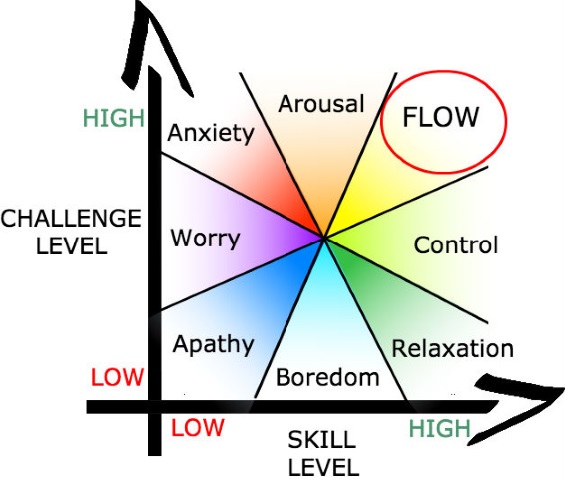
More current research, and more advanced research tools and methods have verified MCs findings. Researchers have found that the state emerges from a radical alteration in normal brain function. In flow, as attention heightens, the slower and energy-expensive extrinsic system (conscious processing) is swapped out for the far faster and more efficient processing of the subconscious, intrinsic system. “It’s an efficiency exchange,” says American University in Beirut neuroscientist Arne Dietrich, who helped discover this phenomenon. “We’re trading energy usually used for higher cognitive functions for heightened attention and awareness.”
As a result, individuals in “flow” enter a state of mind the great psychologist Abraham Maslow terms “peak experience”, and they also are likely to achieve peak performance! Researchers credit flow with most athletic gold medals and world championships, major scientific breakthroughs and significant progress in the arts.
Steve Kotler, in an article for Time Magazine, writes:
“Johns Hopkins neuroscientist Charles Limb used functional magnetic resonance imaging (fMRI) to examine the brains of improv jazz musicians in flow. He found the dorsolateral prefrontal cortex, an area of the brain best known for self-monitoring, deactivated. Self-monitoring is the voice of doubt, that defeatist nag, our inner critic. Since flow is a fluid state—where problem solving is nearly automatic—second guessing can only slow that process. When the dorsolateral prefrontal cortex goes quiet, those guesses are cut off at the source. The result is liberation. We act without hesitation. Creativity becomes more free-flowing, risk taking becomes less frightening, and the combination lets us flow at a far faster clip.”
To achieve a flow state, a balance must be struck between the challenge of the task and the skill of the performer. If the task is too easy or too difficult, flow cannot occur. Both skill level and challenge level must be matched and above average (represented by the center point on the Flow Diagram). For the Dante Opera, the selected performers will have the necessary musical skill level to enter the flow state; they will have achieved at least average competency in singing skills, music reading, intonation, and other necessary skills for operatic performance. IOT Director Karen Saillant will coach and train Dante participants in such a way as to help them experience MC’s “flow state” and “musical flow” (as discussed below) to help them to deliver their optimal performance.
What is the Adagio?
The Adagio was created specifically to measure the underlying “flow” in music. The Adagio is an entirely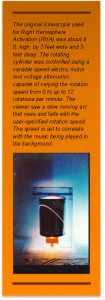 new way to experience and visualize music, to assist in performing music (both as a conductor and/or performer), and to provide a whole new approach to music analysis and theory.
new way to experience and visualize music, to assist in performing music (both as a conductor and/or performer), and to provide a whole new approach to music analysis and theory.
Since this is a unique one-of-a-kind instrument that is a new concept to most, it might be useful to initially express to the reader what the Adagio is not:
- It is NOT tied to rhythm. In fact, it is almost the antithesis of rhythm, flowing and pushing back against the discreet rhythmic events.
- It is NOT tied to melody or harmonic content, as “the flow” has no reference to pitch or duration of notes.
- It DOES reveal and measure a previously unquantifiable dimension in music.
The Adagio can be used for music analysis. An article entitled Measuring Flow Rate in Music, demonstrates how The Adagio can be used for music composition analysis, and provides an example using Mozart’s Piano Concerto No. 21, with Murray Perahia and the English Chamber Orchestra.
The Adagio, with repeated use, can positively affect the viewer psychologically. It has been scientifically validated in a research study conducted at Nova University to activate the right brain hemisphere, and to reduce the stress level in the study’s experimental subjects. Another article, Stress Reduction and Right Brain Hemisphere Activation – a Research Study, provides an overview of this study, and contains a link to the original research conducted at Nova University’s Biofeedback Laboratory under the auspices of “the father of neurofeedback”, globally recognized, Dr. Joe Kamiya.
In addition to using Adagio in the music field, the Adagio (a.k.a., “Kinescope”, and “Kintron”), with further research, may prove to be an effective tool in treating stress related diseases and personality/behavioral disorders.
(This link will take you to an example of the Adagio “flow machine” in action, and in this case, synchronized with Mozart’s Piano Concerto No. 21.)
The Connection Between The Adagio and “Flow State”
Relaxation is a key component to achieving MC’s “flow state”. For MC Flow, the individual must first be relaxed, in control of their artistic medium, and then become engaged in a challenging activity. Adagio has been scientifically proven to induce a state of relaxation in the viewer. Additionally, the same Nova University research project determined that viewing the Adagio activated the right brain hemisphere, subsequently subjugating the left brain to a subdominant role (quieting the dorsolateral prefrontal cortex) so that flow and right brain creativity may be more easily attained by the performer. Although the Adagio can stand on its own merits, it can also be considered a perfect “launching pad” for the artist to launch into MC’s Flow State.
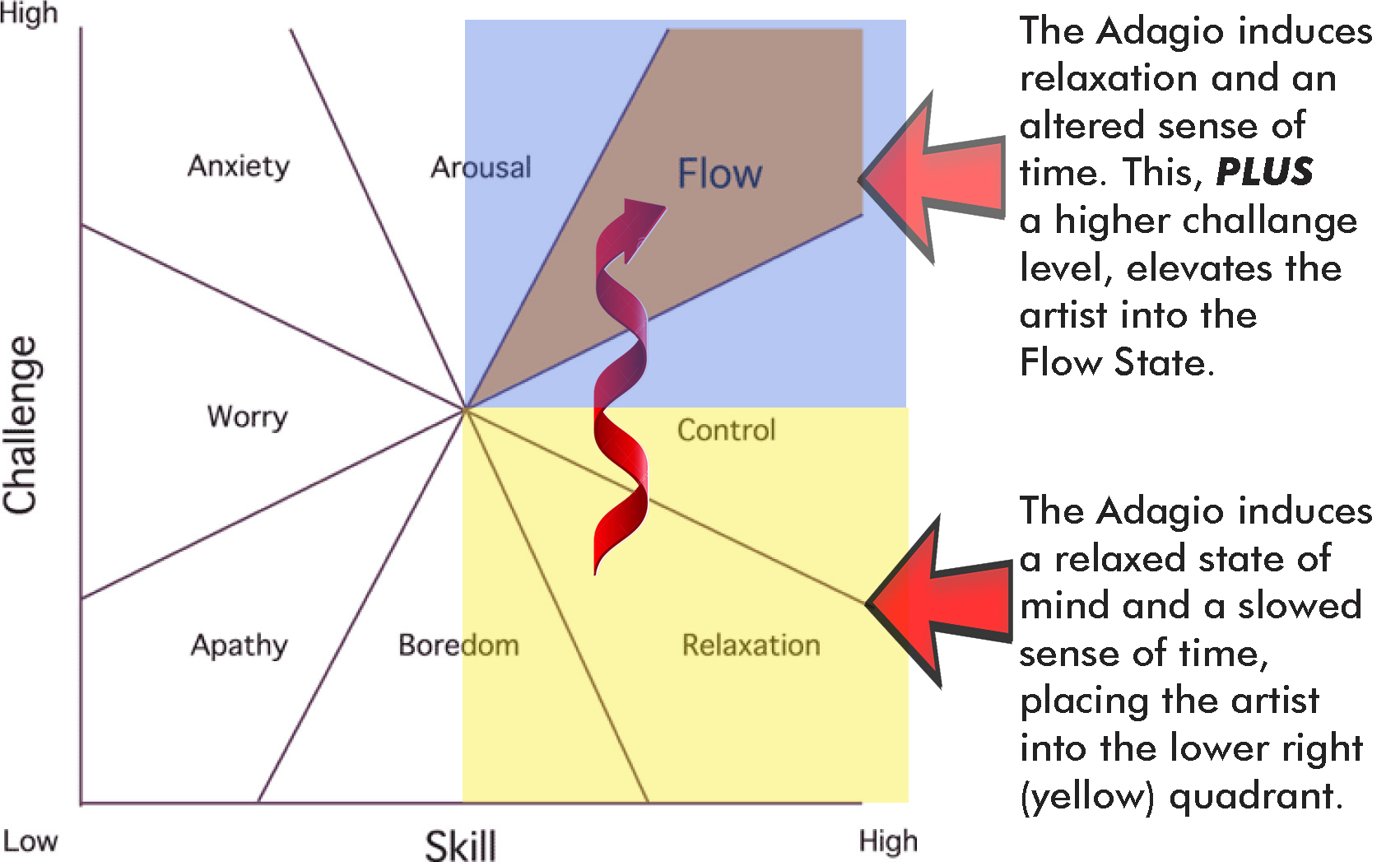
“Flow — the mental state of being completely present and fully immersed in a task — is a strong contributor to creativity. When in flow, the creator and the universe become one, outside distractions recede from consciousness and one’s mind is fully open and attuned to the act of creating. There is very little self-awareness or critical self-judgement; just intrinsic joy for the task.” – Scott Barry Kaufman, Scientific Director, The Imagination Institute
Creativity is associated with the right brain hemisphere. Therefore, it is reasonable to assert that right hemisphere activation, a scientifically validated consequence of viewing the Adagio, helps the singer/musician enter the mysterious, creative state of flow.
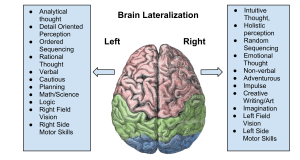
Use of “Flow” to Train Singers and Instrumentalists
IOT Director, Karen Saillant, in collaboration with Italian Maestro Mauro Fabbri, IOT Musical Director and composer of Dante, in conjunction with James Wilson and The Adagio Machine will provide an environment in which Dante opera singers and instrumentalists will be able to enter the flow state and therefore deliver their optimal performance.
Karen Saillant, IOT Director, has dedicated her life to the development of optimum level training techniques for opera singers. A key ingredient to achieving MC’s “flow state”, as we have discussed, is a relatively high level of competency. In the case of opera singers, the ability to allow these needed proficiencies to present as second nature is essential. For opera singers, this means possessing a number of specialized skills. One prong of Ms. Saillant’s six pronged developmental system, which she names The Saillant System or Operatic Photosynthesis, is that of being Harmonious With The Systems of Nature. The most important aspect of this prong is linked to BREATH or Breathing Coordination. Defined by Carl Stough, the individual who discovered it, as the natural way in which the body is meant to breathe, Breathing Coordination may be the single most important ability for all humans, not just opera singers.
In order for Breathing Coordination to exist in singing, meaning the singer never holds his’her breath, the body-mind connection of the singer must be in synergistic coordination, overseen by the reflexive action of the phrenic nerve. For an opera singer, in addition to being able to spontaneously respond and self-organize onstage, as in swarm theory, through the unconscious consensus and self organizing principles of Ms. Saillant’s self discovery prototype, she/he is charged with the ability to respond reflexively in the execution of 7 functional pieces of articulation knowledge which assure the singer’s free flowing breath- all part of The Saillant System.
Unfortunately, many singers do not take the time to inform their bodies of this important information, nor do they practice the execution of these small muscle group, detailed forms of information, which Karen calls “The School Figures of Singing”, in order for these activities to become reflexive. Hence a state of MC-FLOW would not be possible. Ms. Saillant is one of a few disciples of Carl Stough who he personally named to continue his work, the only singer that The Stough Institute of Breathing Coordination sponsored in a New York City recital debut and the only Stough protegee to successfully enable a comatose individual to be able to be taken off of a ventilator, using The Principles of Breathing Coordination & remain, free breathing until their death 1 and 1/2 years later. Ms. Saillant, who has worked with singers in these methodologies for more than 50 years, is uniquely qualified to deliver this specialized training. Karen’s expertise will be instrumental in making sure that the opera participants have the necessary skill level to launch them into the MC Flow State.
The Adagio will be used in the Dante Opera in several ways. James Wilson (inventor of the Adagio), will work with the Dante composer/conductor to ensure the composition and orchestral performance aligns with musical flow. It is well understood that musicians have a tendency to “rush” the music, i.e., to disrupt the music’s natural flow by over anticipating the next note, measure, or phrase (i.e., moving “too quickly” towards some musical cadence or other endpoint). James and Director Karen Saillant will use the Adagio as a tool to help the Dante performers recognize and eliminate this tendency, and thus help them reach their “peak performance” via an accurate sense of the continuous underlying movement.
As noted earlier, James also suggests that Adagio creates a “launching pad” for the performer so that they are more easily transported into the MC “flow state” (this was discussed in more detail in the previous section). Three ingredients are key to achieving flow state; 1. relaxation, 2. above average skill level, and 3. a creative mindset. The Adagio induces relaxation, Karen’s training techniques ensure musical and vocal competency, and the Adagio activates the right hemisphere so the singer is poised for engaging in creative flow.
Use of “Flow” in the Performance of Dante

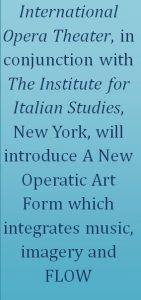
To celebrate the 700th anniversary of the death of Dante, International Opera Theater, in collaboration with The Institute for Italian Culture in New York, and other yet to be named international collaborators, will inaugurate a new operatic art form, as a vehicle to share the poetic, prophetic and ageless work of Dante Alighieri, author of The Divine Comedy, Inferno, The Purgatory, Paradiso, and La Vita Nuova.
We have discussed how Adagio can be used as a tool to assist in training the performers, the conductor and the composer. Since this production will be virtual, other creative opportunities open up. For example, through creative video editing, the Adagio “flow line” might be superimposed in several scenes to accentuate the music and visual flow of said scene (here is an example where the Adagio flow line is superimposed over dancers. However if, where, or when this visual effect is used in the Dante production is TBD by the Creative Director during the production process).
Other uses of the Adagio concept will likely surface as we move through the production process (they usually do!).
Use of “Flow” to Transform the Audience
Painting, sculpture, music, literature and the other arts are often considered to be the repository of a society’s collective memory. Art preserves what fact-based historical records cannot: how it felt to exist in a particular place at a particular time.
With the Dante Opera, our goal is to not only assist the audience in understanding the transformational message embedded in Dante’s extraordinary journey through the Inferno, Purgatorio, and Paradiso, but also to share with the audience the profound and transformational experience of “flow”.
